7 Inserting and Modifying Graphics
Introduction
Although well-illustrated worksheets can’t make up for a lack of content, you can capture your audiences’ attention if your worksheets are vibrant and visually interesting. You can easily enhance a worksheet by adding a picture—one of your own or one of the hundreds that come with Microsoft Excel. If you have the appropriate hardware, such as a sound card and speakers, you can also include sound files and video clips in your workbook.
Microsoft Office comes with a vast array of Clip Art, and there are endless amounts available through other software packages or on the Web. When going online to look at clips, you can categorize them so that it’s easier to find the best choice for your workbook. You can use the Microsoft Office.com Web site to search for and download additional clip art.
If you need to modify your pictures, you can resize them, compress them for storage, change their brightness or contrast, recolor them, or change their shape by cropping them.
WordArt is another feature that adds detail to your workbook. Available in other Office applications, WordArt can bring together your worksheets—you can change its color, shape, shadow, or size. Because WordArt comes with so many style choices, time spent customizing your worksheets is minimal.
In Excel and other Microsoft Office programs, you can insert SmartArt graphics to create diagrams that convey processes or relationships. Excel offers a wide-variety of built-in SmartArt graphic types from which to choose, including graphical lists, process, cycle, hierarchy, relationship, matrix, and pyramid. Using built-in SmartArt graphics makes it easy to create and modify charts without having to create them from scratch.
Locating and Inserting Clip Art
To add a clip art image to a document, you can click the Insert Clip Art button on the Insert tab to open the Clip Art task pane. The Clip Art task pane helps you search for clip art and access the clip art available in the Clip Organizer and on Office.com, a clip gallery that Microsoft maintains on its Web site. You can limit search results to a specific collection of clip art or a specific type of media file. After you find the clip art you want, you can click it to insert it, or point to it to display a list arrow. Then click an available command, such as Insert, Make Available Offline, Edit Keywords, and Delete from Clip Organizer.
Locate and Insert Clip Art
![]() Click the Insert tab.
Click the Insert tab.
![]() Click the Clip Art button.
Click the Clip Art button.
![]() Type the keyword(s) associated with the clip you are looking for.
Type the keyword(s) associated with the clip you are looking for.
To narrow your search, do one of the following:
![]() To limit search results to a specific collection of clip art, click the Search For list arrow, and then select the collections you want to search.
To limit search results to a specific collection of clip art, click the Search For list arrow, and then select the collections you want to search.
![]() To limit search results to a specific type of media file, click the Results Should Be list arrow, and then select the check box next to the types of clips you want to find.
To limit search results to a specific type of media file, click the Results Should Be list arrow, and then select the check box next to the types of clips you want to find.
![]() To display Office.com content, select the Include Office.com content check box (New!).
To display Office.com content, select the Include Office.com content check box (New!).
![]() To access clip art on Office.com, click the link at the bottom of the Clip Art task pane. Search and download images from the Office.com.
To access clip art on Office.com, click the link at the bottom of the Clip Art task pane. Search and download images from the Office.com.
![]() Click Go.
Click Go.
Clips matching the keywords appear in the Results list
![]() Click the clip you want, and then resize it, if necessary.
Click the clip you want, and then resize it, if necessary.
![]() Click the Close button on the task pane.
Click the Close button on the task pane.

Inserting Media Clips
You can insert audio and video motion clips into a workbook by accessing them using the Clip Gallery. A video motion clip is an animated picture—also known as an animated GIF—frequently used in Web pages. When you insert an audio sound, a small icon appears representing the sound file. To play media clips in Microsoft Clip Organizer or in your documents, you need to have Microsoft DirectShow or Microsoft Windows Media Player on your computer. For sounds other than your computer’s internal sounds, you also need a sound card and speakers.
Insert a Clip Gallery Media Clip
![]() Click the Insert tab.
Click the Insert tab.
![]() Click the Clip Art button.
Click the Clip Art button.
![]() Click the Results Should Be list arrow, and then make sure the Videos and/or Audio check boxes are selected.
Click the Results Should Be list arrow, and then make sure the Videos and/or Audio check boxes are selected.
![]() Type the keyword(s) associated with the clip you are looking for.
Type the keyword(s) associated with the clip you are looking for.
![]() Click Go.
Click Go.
Clips matching the keywords appear in the Results list.
![]() To preview a media clip, point to the clip, click the list arrow, and then click Preview/Properties. When you’re done, click Close.
To preview a media clip, point to the clip, click the list arrow, and then click Preview/Properties. When you’re done, click Close.
![]() Click the media you want to insert.
Click the media you want to insert.
![]() To play an audio sound or video using Windows Media Player, double-click the sound icon.
To play an audio sound or video using Windows Media Player, double-click the sound icon.
To play a motion clip, preview your workbook as a Web page, or save your workbook or worksheet as a Web page, and then view it in a Web browser.
![]() Click the Close button on the task pane.
Click the Close button on the task pane.
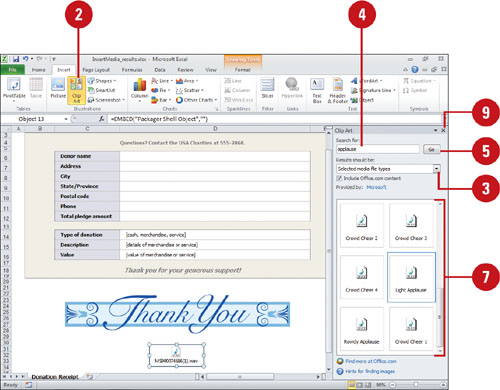
Accessing Clip Art on the Web
If you can’t find the image that you want in the Clip Organizer, you can search for additional images in Clip art on Office Online, a clip gallery that Microsoft maintains on its Web site. To access Clip Art on Office.com, you can click the link at the bottom of the Clip Art task pane or click the Clips Online button on the Clip Organizer toolbar. This launches your Web browser and navigates you directly to the Office.com Web site, where you can access thousands of free clip art images.
Open Clips Online and View Clips in a Category
![]() Click the Insert tab.
Click the Insert tab.
![]() Click the Clip Art button.
Click the Clip Art button.
![]() Click Find more at Office.com.
Click Find more at Office.com.
Your Web browser displays the Microsoft Office Web page.
![]() If necessary, click the Accept button on the Web page.
If necessary, click the Accept button on the Web page.
![]() Click the name of the category you want.
Click the name of the category you want.
![]() To refine the categories, click any of the check boxes in the left pane.
To refine the categories, click any of the check boxes in the left pane.
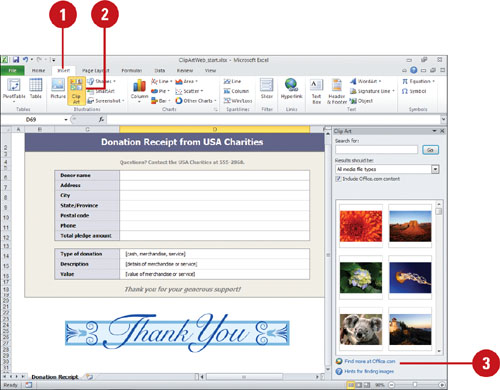

Search for a Clip
![]() In the Clip Art task pane, click the Find more at Office.com link.
In the Clip Art task pane, click the Find more at Office.com link.
Your Web browser displays the Microsoft Office Web page.
![]() Click the Search box.
Click the Search box.
![]() Type a keyword.
Type a keyword.
![]() Click the Search button.
Click the Search button.
![]() Review and refine the search results.
Review and refine the search results.

Download a Clip
![]() Once you have displayed a list of clips on the Office Online Web page, point to a clip, and then click Add to Basket.
Once you have displayed a list of clips on the Office Online Web page, point to a clip, and then click Add to Basket.
![]() To download the images in your basket, point to the Selection Basket link, and then click Download.
To download the images in your basket, point to the Selection Basket link, and then click Download.
![]() To remove a clip from the selection basket, click View, and then click Remove.
To remove a clip from the selection basket, click View, and then click Remove.
![]() Review the Terms of Use, and then click Accept.
Review the Terms of Use, and then click Accept.
![]() If a security virus warning dialog box appears, click Yes, and then click Continue.
If a security virus warning dialog box appears, click Yes, and then click Continue.
![]() If necessary, click Download, and then click Open.
If necessary, click Download, and then click Open.
The clip is stored on your hard disk and shown in your Clip Organizer where you can categorize it.
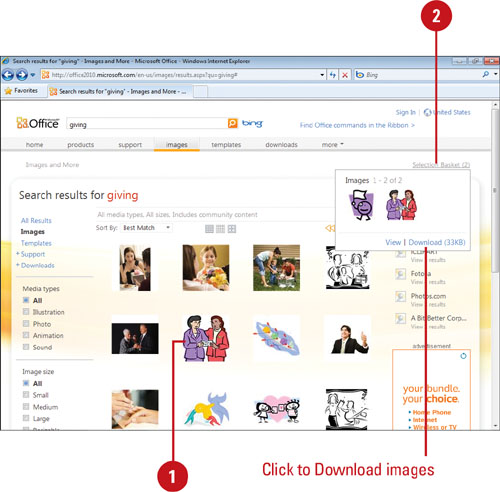
Organizing Clips into Categories
The clips that come with Excel are already organized, but if you’ve added clips without organizing them, it’s probably hard to find what you need in a hurry. The Microsoft Clip Organizer sorts clip art images, pictures, audio sounds, and motion clips into categories. The Clip Organizer allows you to organize and select clips from Microsoft Office, from the Web, and from your personal collection of clips. To help you quickly locate a clip, you can place it in one or more categories. You can also assign one or more keywords to a clip and modify the description of a clip. When you add media files, Clip Organizer automatically creates new sub-collections under My Collections. These files are named after the corresponding folders on your hard disk. The Clip Art task pane helps you search for clip art in the Clip Organizer.
Categorize a Clip
![]() Click the Start button, point to All Programs, click Microsoft Office, click Microsoft Office 2010 Tools, and then click Microsoft Clip Organizer.
Click the Start button, point to All Programs, click Microsoft Office, click Microsoft Office 2010 Tools, and then click Microsoft Clip Organizer.
![]() In Clip Organizer, click the File menu, point to Add Clips to Organizer, and then click On My Own.
In Clip Organizer, click the File menu, point to Add Clips to Organizer, and then click On My Own.
![]() Locate the folder that contains the clip you want to add, and then select the clip.
Locate the folder that contains the clip you want to add, and then select the clip.
![]() Click the Add To button.
Click the Add To button.
![]() Click the collection to which you want to add the clip, or click New to create a new folder.
Click the collection to which you want to add the clip, or click New to create a new folder.
![]() Click OK.
Click OK.
![]() Click Add.
Click Add.


Change Clip Properties
![]() Click the Start button, point to All Programs, click Microsoft Office, click Microsoft Office 2010 Tools, and then click Microsoft Clip Organizer.
Click the Start button, point to All Programs, click Microsoft Office, click Microsoft Office 2010 Tools, and then click Microsoft Clip Organizer.
![]() To create a new collection folder, click the File menu, click New Collection, type a name, select a location, and then click OK.
To create a new collection folder, click the File menu, click New Collection, type a name, select a location, and then click OK.
![]() In the Clip Organizer, find and point to the clip you want to categorize or change the properties of, click the list arrow, and then click one of the following:
In the Clip Organizer, find and point to the clip you want to categorize or change the properties of, click the list arrow, and then click one of the following:
![]() Click Copy to Collection to place a copy of the clip in another category.
Click Copy to Collection to place a copy of the clip in another category.
![]() Click Move to Collection to move the clip to another category.
Click Move to Collection to move the clip to another category.
![]() Click Edit Keywords to edit the caption of the clip and to edit keywords used to find the clip.
Click Edit Keywords to edit the caption of the clip and to edit keywords used to find the clip.
![]() Click the Close button to close the Clip Organizer dialog box.
Click the Close button to close the Clip Organizer dialog box.
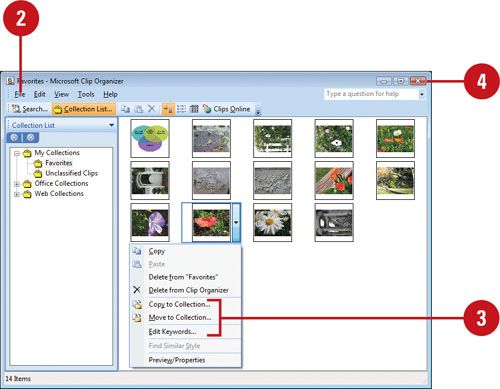
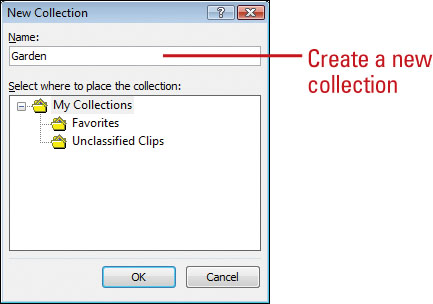

Adding and Removing Clips
You might want to add pictures and categories to the Clip Organizer for easy access in the future. You can import your own clips (pictures, photographs, audio sounds, and videos) into the Clip Organizer. For example, if you have a company logo that you plan to include in more than one workbook, add it to the Clip Organizer. You can also add groups of clips to the Clip Organizer. If you no longer need a picture in the Clip Organizer, you can remove it, which also saves space on your computer.
Add a Clip
![]() Click the Start button, point to All Programs, click Microsoft Office, click Microsoft Office 2010 Tools, and then click Microsoft Clip Organizer.
Click the Start button, point to All Programs, click Microsoft Office, click Microsoft Office 2010 Tools, and then click Microsoft Clip Organizer.
![]() In Clip Organizer, click the File menu, point to Add Clips to Organizer, and then click On My Own.
In Clip Organizer, click the File menu, point to Add Clips to Organizer, and then click On My Own.
![]() Click the Look in list arrow, and then select the folder that contain the clip you want to import.
Click the Look in list arrow, and then select the folder that contain the clip you want to import.
![]() Click the File as type list arrow, and then select the file type.
Click the File as type list arrow, and then select the file type.
![]() Click the clips you want to import.
Click the clips you want to import.
![]() Click Add.
Click Add.
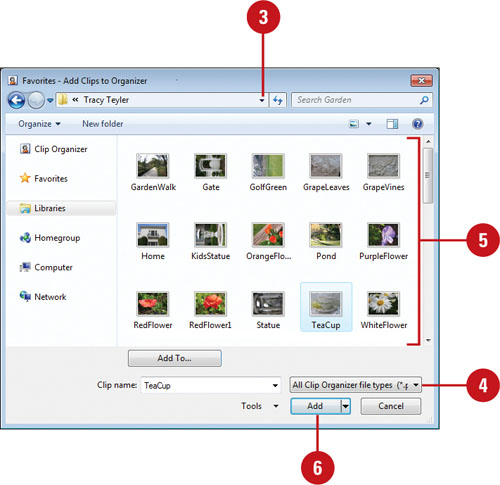
Remove a Clip
![]() Click the Start button, point to All Programs, click Microsoft Office, click Microsoft Office 2010 Tools, and then click Microsoft Clip Organizer.
Click the Start button, point to All Programs, click Microsoft Office, click Microsoft Office 2010 Tools, and then click Microsoft Clip Organizer.
![]() In Clip Organizer, point to the clip you want to remove, and then click the list arrow.
In Clip Organizer, point to the clip you want to remove, and then click the list arrow.
![]() To delete the clip from all Clip Organizer categories, click Delete from Clip Organizer.
To delete the clip from all Clip Organizer categories, click Delete from Clip Organizer.
To remove the clip from just one category, click Delete from the listed category.

Inserting a Picture
Excel makes it possible for you to insert pictures, graphics, scanned photographs, art, photos, or artwork from a DVD or CD-ROM disc or other program into a worksheet. When you use the Picture button on the Insert tab, you specify the source of the picture. When you insert pictures from files on your hard disk drive, scanner, digital camera, or Web camera, Excel allows you to select multiple pictures, view thumbnails of them, and insert them all at once, which speeds up the process.
Insert a Picture from a File
![]() Click the Insert tab.
Click the Insert tab.
![]() Click the Picture button.
Click the Picture button.
![]() Click the Look in list arrow, and then select the drive and folder that contain the file you want to insert.
Click the Look in list arrow, and then select the drive and folder that contain the file you want to insert.
![]() Click the file you want to insert.
Click the file you want to insert.
![]() Click Insert.
Click Insert.
![]() To link a picture file, click the Insert button arrow, and then click Link to File.
To link a picture file, click the Insert button arrow, and then click Link to File.
![]() To insert and link a picture file, click the Insert button arrow, and then click Insert and Link.
To insert and link a picture file, click the Insert button arrow, and then click Insert and Link.
TROUBLE? If you see a red “x” instead of a picture or motion clip in your workbook, then you don’t have a graphics filter installed on your computer for that clip.


Inserting a Picture Screen Shot
If you’re working on a training manual, presentation, or document that requires a picture of your computer screen, then the Screenshot button (New!) on the Insert tab just made your life a lot easier. You use the Screen Clipping tool to drag a selection around the screen area that you want to capture, and then select the picture from the Screenshot gallery. The Screenshot gallery holds multiple screen shots, so you can capture several screens before you insert them into your document. After you insert the screen shot into a document, you can use the tools on the Picture Tools tab to edit and improve it.
Insert a Picture Screen Shot
![]() Click the Insert tab.
Click the Insert tab.
![]() Click the Screenshot button.
Click the Screenshot button.
![]() Click Screen Clipping.
Click Screen Clipping.
![]() Display the screen you want to capture, and then drag the large plus cursor to select the screen area to capture.
Display the screen you want to capture, and then drag the large plus cursor to select the screen area to capture.
![]() Click the Screenshot button, and then click the thumbnail of the screen shot you want to insert.
Click the Screenshot button, and then click the thumbnail of the screen shot you want to insert.
![]() Use the tools on the Picture Tools tab to edit and improve the screen shot.
Use the tools on the Picture Tools tab to edit and improve the screen shot.

Adding an Artistic Style to a Picture
With the Artistic Quick Style gallery (New!), you can transform a picture into a piece of artwork. The Artistic Quick Style gallery makes it easy to change the look of a picture to a sketch, drawing, or painting. The Picture Quick Style gallery provides a variety of different formatting options—such as Pencil Sketch, Line Drawing, Watercolor Sponge, Mosaic Bubble, Glass, Pastels Smooth, Plastic Wrap, Photocopy, and Paint Strokes—to create a professional look. To quickly see if you like an Artistic Quick Style, point to a thumbnail in the gallery to display a live preview of it in the selected shape. If you like it, you can apply it.
Add an Artistic Style to a Picture
![]() Click the picture you want to change.
Click the picture you want to change.
![]() Click the Format tab under Picture Tools.
Click the Format tab under Picture Tools.
![]() Click the Artistic Effects button.
Click the Artistic Effects button.
The current style appears highlighted in the gallery.
![]() Point to a style.
Point to a style.
A live preview of the style appears in the picture.
![]() Click the style you want from the gallery to apply it to the selected picture.
Click the style you want from the gallery to apply it to the selected picture.

Adding a Quick Style to a Picture
Instead of changing individual attributes of a picture—such as shape, border, and effects—you can quickly add them all at once with the Picture Quick Style gallery. The Picture Quick Style gallery provides a variety of different formatting combinations to create a professional look. To quickly see if you like a Picture Quick Style, point to a thumbnail in the gallery to display a live preview of it in the selected shape. If you like it, you can apply it.
Add a Quick Style to a Picture
![]() Click the picture you want to change.
Click the picture you want to change.
![]() Click the Format tab under Picture Tools.
Click the Format tab under Picture Tools.
![]() Click the scroll up or down arrow, or click the More list arrow in the Picture Styles group to see additional styles.
Click the scroll up or down arrow, or click the More list arrow in the Picture Styles group to see additional styles.
The current style appears highlighted in the gallery.
![]() Point to a style.
Point to a style.
A live preview of the style appears in the current shape.
![]() Click the style you want from the gallery to apply it to the selected picture.
Click the style you want from the gallery to apply it to the selected picture.
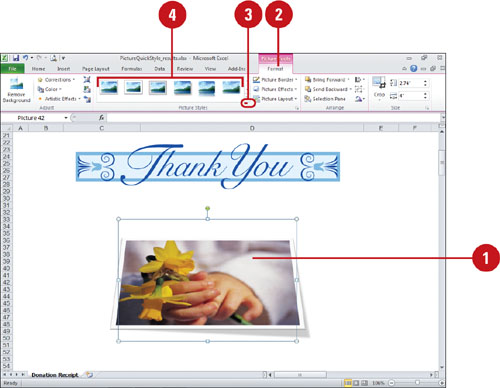
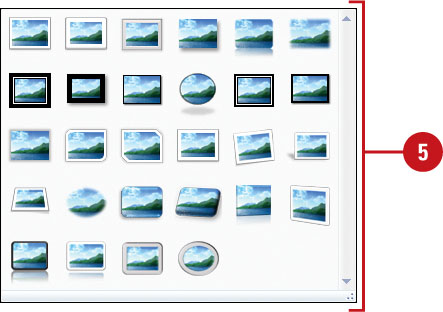
Applying a Shape to a Picture
After you insert a picture into your document, you can select it and apply one of Excel’s shapes to it. The picture appears in the shape just like it has been cropped. The Crop to Shape gallery (New!) makes it easy to choose the shape you want to use. Live preview is not available with the Crop to Shape gallery. You can try different shapes to find the one you want. If you don’t find the one you want, you can use the Reset Picture button to return the picture back to its original state.
Apply a Shape to a Picture
![]() Click the picture you want to change.
Click the picture you want to change.
![]() Click the Format tab under Picture Tools.
Click the Format tab under Picture Tools.
![]() Click the Crop button arrow, and then point to Crop to Shape.
Click the Crop button arrow, and then point to Crop to Shape.
![]() Select the shape you want to apply to the selected picture.
Select the shape you want to apply to the selected picture.
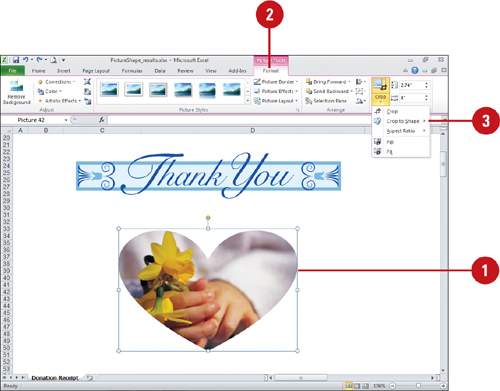

Applying a Border to a Picture
After you insert a picture, you can add and modify the picture border by changing individual outline formatting using the Picture Border button on the Format tab under Picture Tools. The Picture Border button works just like the Shape Outline button and provides similar options to add a border, select a border color, and change border width and style. You can try different border combinations to find the one you want. If you don’t find one that works for you, you can use the No Outline command on the Picture Border gallery to remove it.
Apply a Border to a Picture
![]() Click the picture you want to change.
Click the picture you want to change.
![]() Click the Format tab under Picture Tools.
Click the Format tab under Picture Tools.
![]() Click the Picture Border button.
Click the Picture Border button.
![]() Click a color, or point to Weight, or Dashes, and then select a style, or click More Lines to select multiple options.
Click a color, or point to Weight, or Dashes, and then select a style, or click More Lines to select multiple options.
![]() Drag a sizing handle to change the size or angle of the line or arrow.
Drag a sizing handle to change the size or angle of the line or arrow.
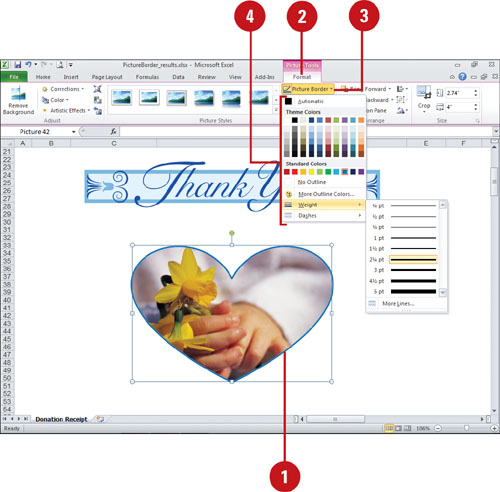
Applying Picture Effects
You can change the look of a picture by applying effects, such as shadows, reflections, glow, soft edges, and 3-D rotations. You can also apply effects to a shape by using the Picture Effects gallery for quick results, or by using the Format Shape dialog box for custom results. From the Picture Effects gallery, you can apply a built-in combination of 3-D effects or individual effects to a picture. To quickly see if you like a picture effect, point to a thumbnail in the Picture Effects gallery to display a live preview of it. If you like it, you can apply it. If you no longer want to apply a picture effect to an object, you can remove it. Simply select the picture, point to the effect type on the Picture Effects gallery, and then select the No effect type option.
Add an Effect to a Picture
![]() Click the picture you want to change.
Click the picture you want to change.
![]() Click the Format tab under Picture Tools.
Click the Format tab under Picture Tools.
![]() Click the Picture Effects button, and then point to one of the following:
Click the Picture Effects button, and then point to one of the following:
![]() Preset to select No 3-D, one of the preset types, or More 3-D Settings.
Preset to select No 3-D, one of the preset types, or More 3-D Settings.
![]() Shadow to select No Shadow, one of the shadow types, or More Shadows.
Shadow to select No Shadow, one of the shadow types, or More Shadows.
![]() Reflection to select No Reflection or one of the Reflection Variations.
Reflection to select No Reflection or one of the Reflection Variations.
![]() Glow to select No Glow, one of the Glow Variations, or More Glow Colors.
Glow to select No Glow, one of the Glow Variations, or More Glow Colors.
![]() Soft Edges to select No Soft Edges or a point size to determine the soft edge amount.
Soft Edges to select No Soft Edges or a point size to determine the soft edge amount.
![]() 3-D Rotation to select No Rotation, one of the rotation types, or More 3-D Settings.
3-D Rotation to select No Rotation, one of the rotation types, or More 3-D Settings.
When you point to an effect, a live preview of the style appears in the current shape.
![]() Click the effect you want from the gallery to apply it to the selected shape.
Click the effect you want from the gallery to apply it to the selected shape.
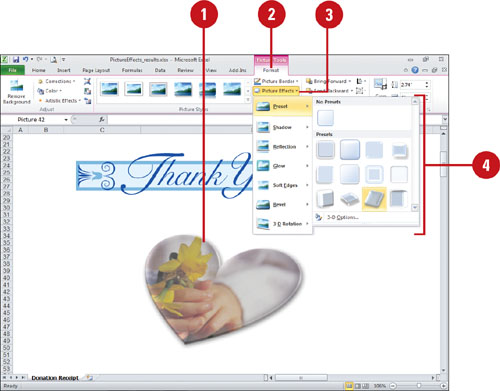
Modifying Picture Size
Once you have inserted a picture, clip art and other objects into your document, you can adapt them to meet your needs. Like any object, you can resize a picture. You can use the sizing handles to quickly resize a picture or use height and width options in the Size group on the Format tab to resize a picture more precisely. If you want to set unique or multiple options at the same time, you can use the Size and Position dialog box. These options allow you to make sure your pictures keep the same relative proportions as the original and lock size proportions.
Resize a Picture
![]() Click the object you want to resize.
Click the object you want to resize.
![]() Drag one of the sizing handles to increase or decrease the object’s size.
Drag one of the sizing handles to increase or decrease the object’s size.
![]() Drag a middle handle to resize the object up, down, left, or right.
Drag a middle handle to resize the object up, down, left, or right.
![]() Drag a corner handle to resize the object proportionally.
Drag a corner handle to resize the object proportionally.
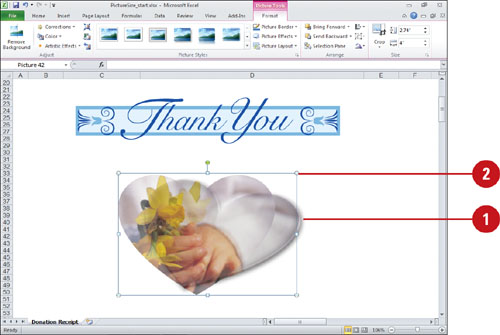
Resize a Picture Precisely
![]() Click the object you want to resize.
Click the object you want to resize.
![]() Click the Format tab under Picture Tools.
Click the Format tab under Picture Tools.
![]() Click the up and down arrows or enter a number (in inches) in the Height and Width boxes on the Ribbon and press Enter.
Click the up and down arrows or enter a number (in inches) in the Height and Width boxes on the Ribbon and press Enter.
If the Lock aspect ratio check box is selected in the Size and Position dialog box, height or width automatically changes when you change one of them. Click the Size Dialog Box Launcher to change the option.

Precisely Scale a Picture
![]() Click the object you want to resize.
Click the object you want to resize.
![]() Click the Format tab under Picture Tools.
Click the Format tab under Picture Tools.
![]() Click the Size Dialog Box Launcher.
Click the Size Dialog Box Launcher.
![]() To keep the picture proportional, select the Lock aspect ratio check box.
To keep the picture proportional, select the Lock aspect ratio check box.
![]() To keep the picture the same relative size, select the Relative to original picture size check box.
To keep the picture the same relative size, select the Relative to original picture size check box.
![]() Click the up and down arrows or enter a number in the Height and Width boxes in one of the following:
Click the up and down arrows or enter a number in the Height and Width boxes in one of the following:
![]() Size. Enter a height and width size in inches.
Size. Enter a height and width size in inches.
![]() Scale. Enter a percentage size.
Scale. Enter a percentage size.
If the Lock aspect ratio check box is selected, height or width automatically changes when you change one of them.
![]() If you want to remove your changes, click Reset.
If you want to remove your changes, click Reset.
![]() Click Close.
Click Close.
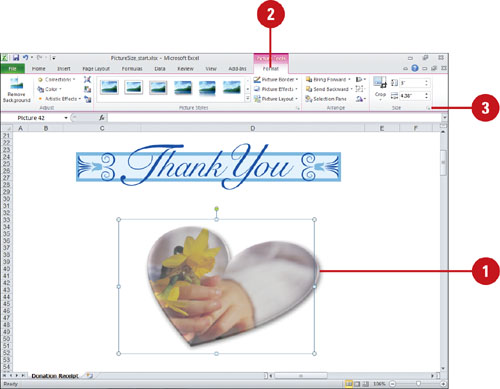
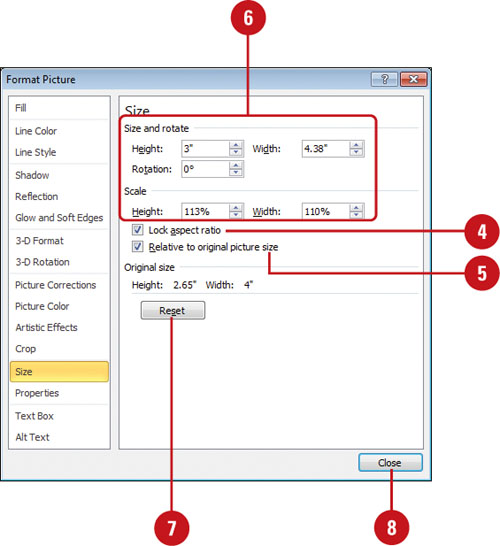
Compressing a Picture
Excel allows you to compress pictures in order to minimize the file size of the image. In doing so, however, you may lose some visual quality, depending on the compression setting (New!). You can pick the resolution that you want for the pictures in a document based on where or how they’ll be viewed (for example, on the Web or printed). You can also set other options, such as Delete cropped areas of picture, to get the best balance between picture quality and file size or automatically compress pictures when you save your document.
Compress a Picture
![]() Click to select the pictures you want to compress.
Click to select the pictures you want to compress.
![]() Click the Format tab under Picture Tools.
Click the Format tab under Picture Tools.
![]() Click the Compress Pictures button.
Click the Compress Pictures button.
![]() Select the Apply only to this picture check box to apply compression setting to only the selected picture. Otherwise, clear the check box to compress all pictures in your document.
Select the Apply only to this picture check box to apply compression setting to only the selected picture. Otherwise, clear the check box to compress all pictures in your document.
![]() Select or clear the Delete cropped areas of pictures check box to reduce file.
Select or clear the Delete cropped areas of pictures check box to reduce file.
![]() Click the Print, Screen, E-mail, or Document (New!) option to specify a target output.
Click the Print, Screen, E-mail, or Document (New!) option to specify a target output.
![]() Click OK.
Click OK.


Correcting a Picture
Once you have inserted a picture, you can control the image’s colors, brightness, and contrast using Picture tools. The brightness and contrast controls let you make simple adjustments to the tonal range of a picture. The brightness and contrast controls change a picture by an overall lightening or darkening of the image pixels. In addition, you can sharpen and soften pictures by a specified percentage (New!). You can experiment with the settings to get the look you want. If you don’t like the look, you can use the Reset Picture button to return the picture back to its original starting point.
Change Brightness and Contrast or Sharpen and Soften
![]() Click the picture you want to change.
Click the picture you want to change.
![]() Click the Format tab under Picture Tools.
Click the Format tab under Picture Tools.
![]() Click the Corrections button, and then do one of the following:
Click the Corrections button, and then do one of the following:
![]() Brightness and Contrast. Click a brightness and contrast option.
Brightness and Contrast. Click a brightness and contrast option.
A positive brightness lightens the object colors by adding more white, while a negative brightness darkens the object colors by adding more black. A positive contrast increases intensity, resulting in less gray, while a negative contrast to decrease intensity, resulting in more gray.
![]() Sharpen and Soften. Click a sharpen and soften option.
Sharpen and Soften. Click a sharpen and soften option.
![]() To set custom correction percentages, click the Corrections button, click Picture Corrections Options, specify the options you want, and then click Close.
To set custom correction percentages, click the Corrections button, click Picture Corrections Options, specify the options you want, and then click Close.
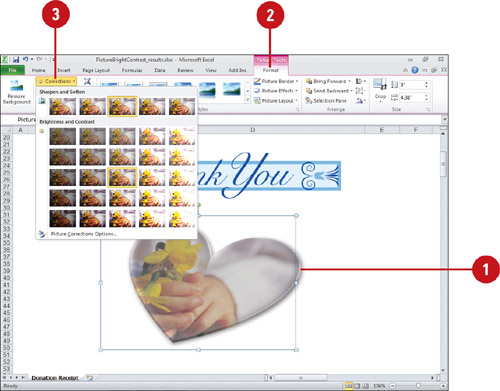

Recoloring a Picture
You can recolor clip art and other objects to match the color scheme of your document. For example, if you use a flower clip art as your business logo, you can change shades of pink in the spring to shades of orange in the autumn. The Color Picture Quick Style gallery (New!) provides a variety of different recolor formatting combinations. To quickly see if you like a Color Picture Quick Style, point to a thumbnail in the gallery to display a live preview of it in the selected shape. If you like it, you can apply it. You can also use a transparent background in your picture to avoid conflict between its background color and your document’s background. With a transparent background, the picture takes on the same background as your document.
Recolor a Picture
![]() Click the picture whose color you want to change.
Click the picture whose color you want to change.
![]() Click the Format tab under Picture Tools.
Click the Format tab under Picture Tools.
![]() Click the Color button.
Click the Color button.
![]() Click one of the Color options.
Click one of the Color options.
![]() Recolor. Click an option to apply a color type:
Recolor. Click an option to apply a color type:
No Recolor. Click this option to remove a previous recolor.
Grayscale. Converts colors into whites, blacks and shades of gray between black and white.
Sepia. Converts colors into very light gold and yellow colors like a picture from the old west.
Washout. Converts colors into whites and very light colors.
Black and White. Converts colors into only white and black.
![]() Color Saturation or Color Tone. Click an option to apply a color saturation or tone based on the recolor selection.
Color Saturation or Color Tone. Click an option to apply a color saturation or tone based on the recolor selection.
![]() More Variations. Point to this option to select a specific color.
More Variations. Point to this option to select a specific color.
![]() Picture Color Options. Click this option to set custom recolor options by percentage.
Picture Color Options. Click this option to set custom recolor options by percentage.

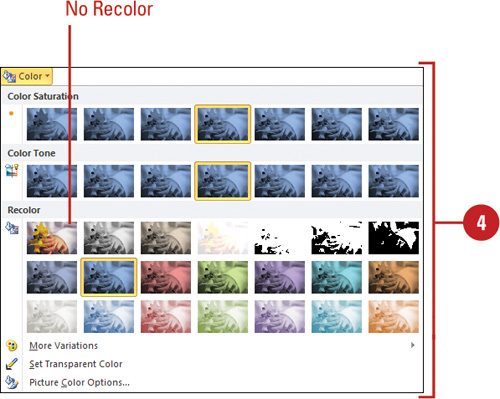
Set a Transparent Background
![]() Click the picture you want to change.
Click the picture you want to change.
![]() Click the Format tab under Picture Tools.
Click the Format tab under Picture Tools.
![]() Click the Color button, and then click Set Transparent Color.
Click the Color button, and then click Set Transparent Color.
![]() Move the pointer over the object until the pointer changes shape.
Move the pointer over the object until the pointer changes shape.
![]() Click the color you want to set as transparent.
Click the color you want to set as transparent.
![]() Move the pointer over the picture where you want to apply the transparent color, and then click to apply it.
Move the pointer over the picture where you want to apply the transparent color, and then click to apply it.
![]() When you’re done, click outside the image.
When you’re done, click outside the image.


Cropping and Rotating a Picture
You can crop clip art to isolate just one portion of the picture. Because clip art uses vector image technology, you can crop even the smallest part of it and then enlarge it, and the clip art will still be recognizable. You can also crop bitmapped pictures, but if you enlarge the area you cropped, you lose picture detail. Use the Crop button to crop an image by hand. In addition, you can crop a picture while maintaining a selected resize aspect ratio (New!) or crop a picture based on a fill or fit (New!). You can also rotate a picture by increments or freehand.
Crop a Picture Quickly
![]() Click the picture you want to crop.
Click the picture you want to crop.
![]() Click the Format tab under Picture Tools.
Click the Format tab under Picture Tools.
![]() Click the Crop button.
Click the Crop button.
![]() Drag the sizing handles until the borders surround the area you want to crop.
Drag the sizing handles until the borders surround the area you want to crop.
![]() Click outside the image when you are finished.
Click outside the image when you are finished.

Crop a Picture with an Aspect Ratio
![]() Click the picture you want to crop.
Click the picture you want to crop.
![]() Click the Format tab under Picture Tools.
Click the Format tab under Picture Tools.
![]() Click the Crop button arrow, point to Aspect Ratio, and then select an aspect ratio.
Click the Crop button arrow, point to Aspect Ratio, and then select an aspect ratio.
![]() Drag the sizing handles until the borders surround the area you want to crop.
Drag the sizing handles until the borders surround the area you want to crop.
![]() Click outside the image when you are finished.
Click outside the image when you are finished.

Crop a Picture with a Fill or Fit
![]() Click the picture you want to crop.
Click the picture you want to crop.
![]() Click the Format tab under Picture Tools.
Click the Format tab under Picture Tools.
![]() Click the Crop button arrow, and then select an option:
Click the Crop button arrow, and then select an option:
![]() Fill. Resizes the picture so the entire picture area is filled while maintaining the aspect ratio. Any area outside of the picture area is cropped.
Fill. Resizes the picture so the entire picture area is filled while maintaining the aspect ratio. Any area outside of the picture area is cropped.
![]() Fit. Resizes the picture so the entire picture displays inside the picture area while maintaining the aspect ratio.
Fit. Resizes the picture so the entire picture displays inside the picture area while maintaining the aspect ratio.
![]() Drag the sizing handles until the borders surround the area you want to crop.
Drag the sizing handles until the borders surround the area you want to crop.
![]() Click outside the image when you are finished.
Click outside the image when you are finished.

Rotate a Picture
![]() Click the object you want to rotate.
Click the object you want to rotate.
![]() Position the pointer (which changes to the Free Rotate pointer) over the green rotate lever at the top of the object, and then drag to rotate the object.
Position the pointer (which changes to the Free Rotate pointer) over the green rotate lever at the top of the object, and then drag to rotate the object.
![]() Click outside the object to set the rotation.
Click outside the object to set the rotation.
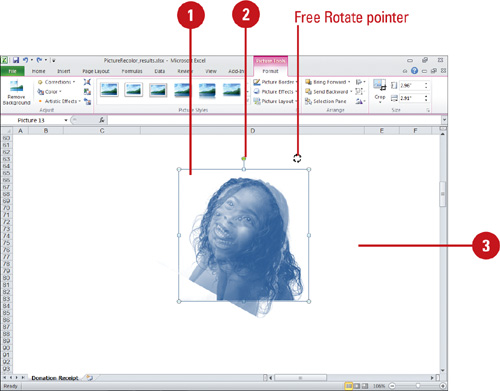
Removing a Picture Background
Sometimes you want to use an element from a picture instead of the entire picture. With the Remove Background command (New!), you can specify the element you want in a picture, and then remove the background. You can use automatic background removal or you can manually draw lines to specify which parts of the picture background you want to keep and which to remove.
Remove a Picture Background
![]() Click the picture you want to change.
Click the picture you want to change.
![]() Click the Format tab under Picture Tools.
Click the Format tab under Picture Tools.
![]() Click the Remove Background button.
Click the Remove Background button.
![]() Drag the handles on the marquee lines to specify the part of the picture you want to keep. The area outside the marquee gets removed.
Drag the handles on the marquee lines to specify the part of the picture you want to keep. The area outside the marquee gets removed.
![]() To manually specify which areas to keep and which areas to remove, do the following:
To manually specify which areas to keep and which areas to remove, do the following:
![]() Mark Areas to Keep. Click the button, and then draw lines to specify which parts of the picture you do not want automatically removed.
Mark Areas to Keep. Click the button, and then draw lines to specify which parts of the picture you do not want automatically removed.
![]() Mark Areas to Remove. Click the button, and then draw lines to specify which parts of the picture you do want removed in addition to those automatically marked.
Mark Areas to Remove. Click the button, and then draw lines to specify which parts of the picture you do want removed in addition to those automatically marked.
![]() Delete Mark. Click the button, and then click marked lines to remove them.
Delete Mark. Click the button, and then click marked lines to remove them.
![]() Click the Keep Changes button to close and keep the removal or click the Discard All Changes button to close and cancel the automatic removal.
Click the Keep Changes button to close and keep the removal or click the Discard All Changes button to close and cancel the automatic removal.

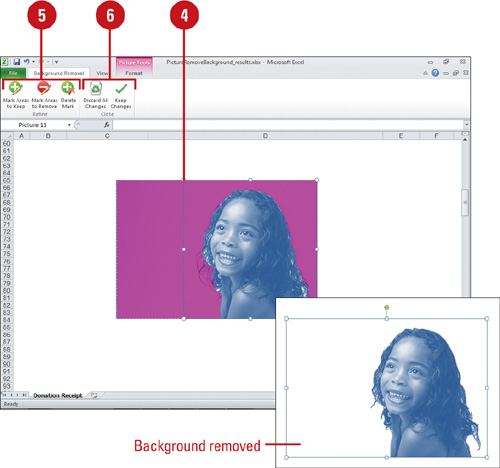
Creating WordArt Text
The WordArt feature lets you create stylized text to draw attention to your most important words. Most users apply WordArt to a word or a short phrase, such as Big Smiles. You should apply WordArt to a document sparingly. Its visual appeal and unique look requires uncluttered space. When you use WordArt, you can choose from a variety of text styles that come with the WordArt Quick Style gallery, or you can create your own using tools in the WordArt Styles group. To quickly see if you like a WordArt Quick Style, point to a thumbnail in the gallery to display a live preview of it in the selected text. If you like it, you can apply it. You can also use the free angle handle (pink diamond) inside the selected text box to adjust your WordArt text angle.
Insert WordArt Text
![]() Click the Insert tab.
Click the Insert tab.
![]() Click the WordArt button, and then click one of the WordArt styles.
Click the WordArt button, and then click one of the WordArt styles.
A WordArt text box appears on the document with selected placeholder text.
![]() Type the text you want WordArt to use.
Type the text you want WordArt to use.
![]() Drag a resize handle as needed to increase or decrease the size of the WordArt text box.
Drag a resize handle as needed to increase or decrease the size of the WordArt text box.
![]() If applicable, use the Font and Paragraph options on the Home tab to modify the text you entered.
If applicable, use the Font and Paragraph options on the Home tab to modify the text you entered.
![]() To edit WordArt text, click to place the insertion point where you want to edit, and then edit the text.
To edit WordArt text, click to place the insertion point where you want to edit, and then edit the text.


Formatting WordArt Text
In addition to applying one of the preformatted WordArt styles, you can also create your own style by shaping your text into a variety of shapes, curves, styles, and color patterns. The WordArt Styles group gives you tools for changing the fill and outline of your WordArt text. To quickly see if you like a WordArt Style, point to a thumbnail in the gallery to display a live preview of it in the selected text. If you like it, you can apply it.
Apply a Different WordArt Style to Existing WordArt Text
![]() Click the WordArt object whose style you want to change.
Click the WordArt object whose style you want to change.
![]() Click the Format tab under Drawing or WordArt Tools.
Click the Format tab under Drawing or WordArt Tools.
![]() Click the scroll up or down arrow, or click the More list arrow in the WordArt Styles group to see additional styles.
Click the scroll up or down arrow, or click the More list arrow in the WordArt Styles group to see additional styles.
The current style appears highlighted in the gallery.
![]() Point to a style.
Point to a style.
A live preview of the style appears in the current shape text.
![]() Click the style you want from the gallery to apply it to the selected shape.
Click the style you want from the gallery to apply it to the selected shape.
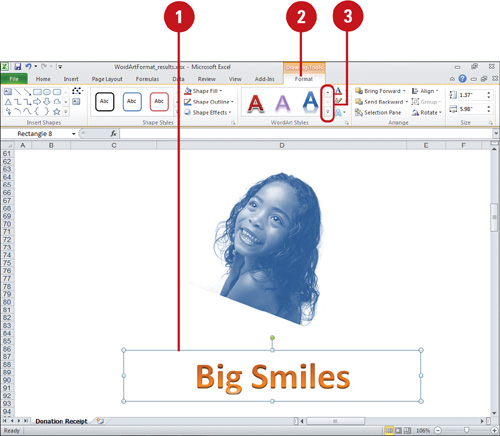

Apply a Fill to WordArt Text
![]() Click the WordArt object you want to change.
Click the WordArt object you want to change.
![]() Click the Format tab under Drawing or WordArt Tools.
Click the Format tab under Drawing or WordArt Tools.
![]() Click the Text Fill or Shape Fill button arrow, and then click or point to one of the following:
Click the Text Fill or Shape Fill button arrow, and then click or point to one of the following:
![]() Color to select a theme or standard color.
Color to select a theme or standard color.
![]() No Fill to remove a fill color.
No Fill to remove a fill color.
![]() Picture to select a picture file.
Picture to select a picture file.
![]() Gradient to select No Gradient, one of the shadow types, or More Gradients.
Gradient to select No Gradient, one of the shadow types, or More Gradients.
![]() Texture to select one of the texture types, or More Textures.
Texture to select one of the texture types, or More Textures.
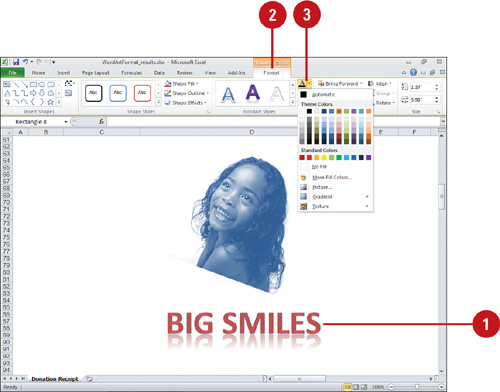
Apply an Outline to WordArt Text
![]() Click the WordArt object you want to change.
Click the WordArt object you want to change.
![]() Click the Format tab under Drawing or WordArt Tools.
Click the Format tab under Drawing or WordArt Tools.
![]() Click the Text Outline or Shape Outline button arrow.
Click the Text Outline or Shape Outline button arrow.
![]() Click a color, or point to Weight or Dashes, and then select a style.
Click a color, or point to Weight or Dashes, and then select a style.
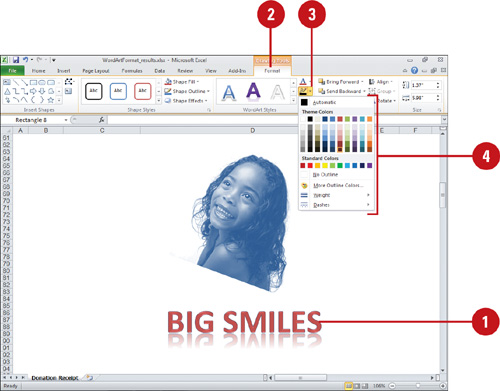
Applying WordArt Text Effects
You can change the look of WordArt text by applying effects, such as shadows, reflections, glow, soft edges, 3-D rotations, and transformations. You can apply effects to a shape by using the Text Effects gallery for quick results. From the Text Effects gallery you can apply a built-in combination of 3-D effects or individual effects to WordArt text. To quickly see if you like the effect, point to a thumbnail in the Text Effects gallery to display a live preview of it. If you like it, you can apply it. If you no longer want to apply the effect, you can remove it. Simply, select the WordArt text, point to the effect type on the Text Effects gallery, and then select the No effect type option.
Apply an Effect to WordArt Text
![]() Click the WordArt object you want to change.
Click the WordArt object you want to change.
![]() Click the Format tab under Drawing or WordArt Tools.
Click the Format tab under Drawing or WordArt Tools.
![]() Click the Text Effects button.
Click the Text Effects button.
![]() For Word, use the Shadow Effects and 3D Effects buttons.
For Word, use the Shadow Effects and 3D Effects buttons.
![]() Point to one of the following:
Point to one of the following:
![]() Shadow to select No Shadow, one of the shadow types (Outer or Inner), or More Shadows.
Shadow to select No Shadow, one of the shadow types (Outer or Inner), or More Shadows.
![]() Reflection to select No Reflection or one of the Reflection Variations.
Reflection to select No Reflection or one of the Reflection Variations.
![]() Glow to select No Glow, one of the Glow Variations, or More Glow Colors.
Glow to select No Glow, one of the Glow Variations, or More Glow Colors.
![]() Bevel to select No Bevel, one of the bevel variations, or More 3-D Settings.
Bevel to select No Bevel, one of the bevel variations, or More 3-D Settings.
![]() 3-D Rotation to select No Rotation, one of the rotation types (Parallel, Perspective, or Oblique), or More 3-D Settings.
3-D Rotation to select No Rotation, one of the rotation types (Parallel, Perspective, or Oblique), or More 3-D Settings.
![]() Transform to select No Transform, or one of the transform types (Follow Path or Warp).
Transform to select No Transform, or one of the transform types (Follow Path or Warp).
![]() Click the effect you want to apply to the selected shape.
Click the effect you want to apply to the selected shape.

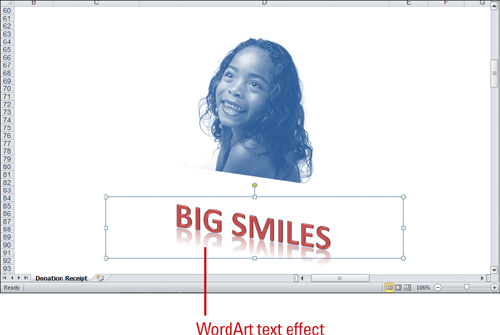
Modifying WordArt Text Position
You can apply a number of text effects to your WordArt objects that determine alignment and direction. The effects of some of the adjustments you make are more pronounced for certain WordArt styles than others. Some of these effects make the text unreadable for certain styles, so apply these effects carefully. You can apply effects to a shape by using the Format Shape dialog box for custom results. You can also use the free rotate handle (green circle) at the top of the selected text box to rotate your WordArt text.
Change WordArt Text Direction
![]() Right-click the WordArt object you want to change, and then click Format Shape or Format WordArt.
Right-click the WordArt object you want to change, and then click Format Shape or Format WordArt.
![]() If necessary, click Text Box in the left pane.
If necessary, click Text Box in the left pane.
![]() Click the Vertical alignment or Horizontal alignment list arrow, and then select an option: Top, Middle, Bottom, Top Center, Middle Center, or Bottom Center.
Click the Vertical alignment or Horizontal alignment list arrow, and then select an option: Top, Middle, Bottom, Top Center, Middle Center, or Bottom Center.
![]() Click the Text Direction list arrow, and then select an option: Horizontal, Rotate all text 90°, Rotate all text 270°, or Stacked.
Click the Text Direction list arrow, and then select an option: Horizontal, Rotate all text 90°, Rotate all text 270°, or Stacked.
![]() Click Close.
Click Close.

Rotate WordArt Text
![]() Click the WordArt object you want to change.
Click the WordArt object you want to change.
![]() Drag the free rotate handle (green circle) to rotate the object in any direction you want.
Drag the free rotate handle (green circle) to rotate the object in any direction you want.
![]() When you’re done, release the mouse button.
When you’re done, release the mouse button.
![]() Click outside the object to deselect it.
Click outside the object to deselect it.
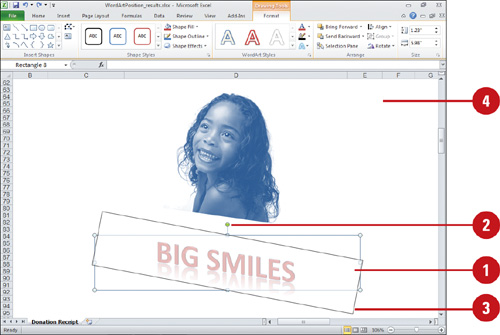
Creating SmartArt Graphics
SmartArt graphics allow you to create diagrams that convey processes or relationships. Office provides a wide variety of built-in SmartArt graphic types, including graphical lists, process, cycle, hierarchy, relationship, matrix, pyramid, picture (New!), and Office.com (New!). Using built-in SmartArt graphics makes it easy to create and modify charts without having to create them from scratch. To quickly see if you like a SmartArt graphic layout, point to a thumbnail in the gallery to display a live preview of it in the selected shape. If you like it, you can apply it.
Create a SmartArt Graphic
![]() Click the Insert tab.
Click the Insert tab.
![]() Click the SmartArt button.
Click the SmartArt button.
![]() In the left pane, click a category, such as All, List, Process, Cycle, Hierarchy, Relationship, Matrix, or Pyramid.
In the left pane, click a category, such as All, List, Process, Cycle, Hierarchy, Relationship, Matrix, or Pyramid.
![]() In the middle pane, click a SmartArt graphic style type.
In the middle pane, click a SmartArt graphic style type.
![]() Click OK.
Click OK.
The SmartArt graphic appears in the document.

![]() Click the Text Pane button, or click the control with two arrows along the left side of the selection to show the Text pane.
Click the Text Pane button, or click the control with two arrows along the left side of the selection to show the Text pane.
![]() Label the shapes by doing one of the following:
Label the shapes by doing one of the following:
![]() Type text in the [Text] box.
Type text in the [Text] box.
You can use the arrow keys to move around the Text pane, or use the Promote or Demote buttons to indent.
![]() At the end of a line, press Enter to insert a line (shape), or select line text, and then press Delete to remove a line (shape).
At the end of a line, press Enter to insert a line (shape), or select line text, and then press Delete to remove a line (shape).
![]() Click a shape, and then type text directly into the shape.
Click a shape, and then type text directly into the shape.
![]() When you’re done, click outside of the SmartArt graphic.
When you’re done, click outside of the SmartArt graphic.
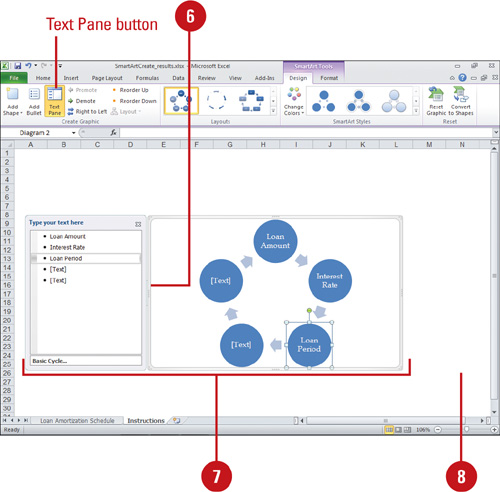
Using the Text Pane with SmartArt Graphics
After you create a layout for a SmartArt graphic, a Text pane appears next to your selected SmartArt graphic. The bottom of the Text pane displays a description of the SmartArt graphic. The Text pane and SmartArt graphic contain placeholder text. You can change the placeholder text in the Text pane or directly in the SmartArt graphic. The Text pane works like an outline or a bulleted list and the text corresponds directly with the shape text in the SmartArt graphic. As you add and edit content, the SmartArt graphic automatically updates, adding or removing shapes as needed while maintaining the design. If you see a red “x” in the Text pane, it means that the SmartArt graphic contains a fixed number of shapes, such as Counterbalance Arrows (only two).
Show or Hide the Text Pane
![]() Click the SmartArt graphic you want to modify.
Click the SmartArt graphic you want to modify.
![]() Click the Design tab under SmartArt Tools.
Click the Design tab under SmartArt Tools.
![]() Do any of the following:
Do any of the following:
![]() Show. Click the Text Pane button, or click the control with two arrows along the left side of the SmartArt graphic selection to show the Text pane.
Show. Click the Text Pane button, or click the control with two arrows along the left side of the SmartArt graphic selection to show the Text pane.
![]() Hide. Click the Text Pane button, click the Close button on the Text pane, deselect the SmartArt graphic.
Hide. Click the Text Pane button, click the Close button on the Text pane, deselect the SmartArt graphic.
The Text Pane button toggles to show or hide the Text pane.

Work with Text in the Text Pane
![]() Click the SmartArt graphic you want to modify.
Click the SmartArt graphic you want to modify.
![]() Click the Design tab under SmartArt Tools.
Click the Design tab under SmartArt Tools.
![]() If necessary, click the Text Pane button to show the Text pane.
If necessary, click the Text Pane button to show the Text pane.
![]() Do any of the following tasks:
Do any of the following tasks:
![]() New line. At the end of a line, press Enter.
New line. At the end of a line, press Enter.
![]() Indent line right. Press Tab, or click the Promote button.
Indent line right. Press Tab, or click the Promote button.
![]() Indent line left. Press Shift+Tab, or click the Demote button.
Indent line left. Press Shift+Tab, or click the Demote button.
![]() Delete line. Select the line text, and then press Delete.
Delete line. Select the line text, and then press Delete.

Modifying a SmartArt Graphic
After you create a SmartArt graphic, you can add, remove, change, or rearrange shapes to create a custom look. For shapes within a SmartArt graphic, you can change the shape from the Shape gallery or use familiar commands, such as Bring to Front, Send to Back, Align, Group, and Rotate, to create your own custom SmartArt graphic. If you no longer want a shape you’ve added, simply select it, and then press Delete to remove it.
Add a Shape to a SmartArt Graphic
![]() Select the shape in the SmartArt graphic you want to modify.
Select the shape in the SmartArt graphic you want to modify.
![]() Click the Design tab under SmartArt Tools.
Click the Design tab under SmartArt Tools.
![]() Click the Add Shape button to insert a shape at the end, or click the Add Shape button arrow, and then select the position where you want to insert a shape.
Click the Add Shape button to insert a shape at the end, or click the Add Shape button arrow, and then select the position where you want to insert a shape.
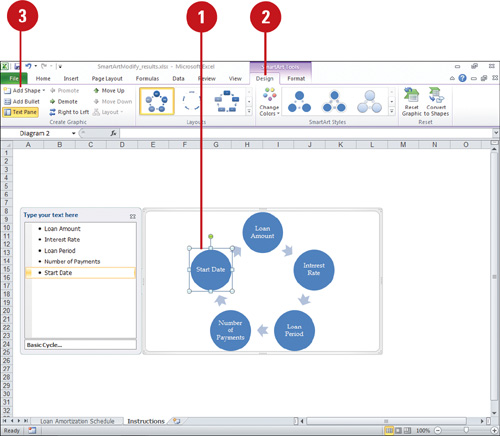
Change Shapes in a SmartArt Graphic
![]() Select the shapes in the SmartArt graphic you want to modify.
Select the shapes in the SmartArt graphic you want to modify.
![]() Click the Format tab under SmartArt Tools.
Click the Format tab under SmartArt Tools.
![]() Click the Change Shape button, and then click a shape.
Click the Change Shape button, and then click a shape.

Resizing a SmartArt Graphic
You can change the size of individual shapes within a SmartArt graphic or of an entire SmartArt graphic. If the size of an individual shape within a SmartArt graphic changes, the other shapes in the graphic may also change based on the type of layout. When you resize a shape with text or increase or decrease text size, the text may automatically resize to fit the shape depending on the space available in the SmartArt graphic. When you resize an entire SmartArt graphic, shapes within it scale proportionally or adjust to create the best look.
Resize a SmartArt Graphic
![]() Select the shapes in the SmartArt graphic or the entire SmartArt graphic you want to modify.
Select the shapes in the SmartArt graphic or the entire SmartArt graphic you want to modify.
![]() Click the Format tab under SmartArt Tools.
Click the Format tab under SmartArt Tools.
![]() Use one of the following methods:
Use one of the following methods:
![]() Drag a middle handle to resize the object up, down, left, or right.
Drag a middle handle to resize the object up, down, left, or right.
![]() Drag a corner handle to resize the object proportionally.
Drag a corner handle to resize the object proportionally.
![]() Click the Size button, and then specify the size you want.
Click the Size button, and then specify the size you want.
![]() Click the Larger or Smaller button to increase or decrease the object in standard increments.
Click the Larger or Smaller button to increase or decrease the object in standard increments.

Formatting a SmartArt Graphic
If your current SmartArt graphics don’t quite convey the message or look you want, use live preview to quickly preview layouts in the Quick Styles and Layout Styles groups and select the one you want. If you only want to change the color, you can choose different color schemes using theme colors by using the Change Color button. If the flow of a SmartArt graphic is not the direction you want, you can change the orientation.
Apply a Quick Style to a SmartArt Graphic
![]() Click the SmartArt graphic you want to modify.
Click the SmartArt graphic you want to modify.
![]() Click the Design tab under SmartArt Tools.
Click the Design tab under SmartArt Tools.
![]() Click the scroll up or down arrow, or click the More list arrow in the Quick Styles group to see additional styles.
Click the scroll up or down arrow, or click the More list arrow in the Quick Styles group to see additional styles.
![]() Point to a style.
Point to a style.
A live preview of the style appears in the current shape.
![]() Click the layout for the SmartArt graphic you want from the gallery.
Click the layout for the SmartArt graphic you want from the gallery.
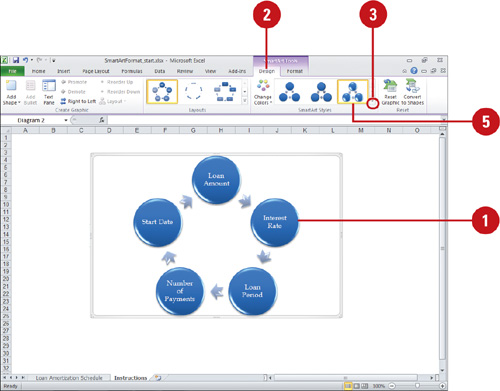
Change a Smart Graphic Orientation
![]() Click the SmartArt graphic you want to modify.
Click the SmartArt graphic you want to modify.
![]() Click the Design tab under SmartArt Tools.
Click the Design tab under SmartArt Tools.
![]() Click the Right to Left button.
Click the Right to Left button.
The button toggles, so you can click it again to switch back.

Change a SmartArt Graphic Layout
![]() Click the SmartArt graphic you want to modify.
Click the SmartArt graphic you want to modify.
![]() Click the Design tab under SmartArt Tools.
Click the Design tab under SmartArt Tools.
![]() Click the scroll up or down arrow, or click the More list arrow in the Layout Styles group to see additional styles.
Click the scroll up or down arrow, or click the More list arrow in the Layout Styles group to see additional styles.
The gallery displays layouts designed for bulleted lists.
![]() To view the entire list of diagram layouts, click More Layouts.
To view the entire list of diagram layouts, click More Layouts.
![]() Point to a layout.
Point to a layout.
A live preview of the style appears in the current shape.
![]() Click the layout for the SmartArt graphic you want from the gallery.
Click the layout for the SmartArt graphic you want from the gallery.
![]() If you opened the entire list of layouts, click OK.
If you opened the entire list of layouts, click OK.
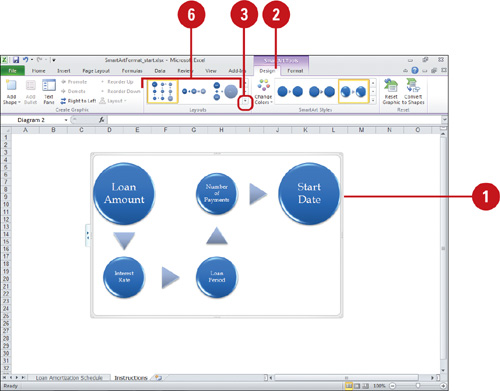
Change a SmartArt Graphic Colors
![]() Click the SmartArt graphic you want to modify.
Click the SmartArt graphic you want to modify.
![]() Click the Design tab under SmartArt Tools.
Click the Design tab under SmartArt Tools.
![]() Click the Change Colors button.
Click the Change Colors button.
The gallery displays the current layout with different theme colors.
![]() Point to a style.
Point to a style.
A live preview of the style appears in the current shape.
![]() Click the layout for the SmartArt graphic you want from the gallery.
Click the layout for the SmartArt graphic you want from the gallery.
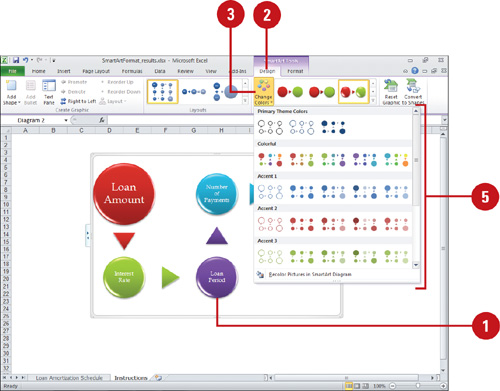
Formatting a Shape in a SmartArt Graphic
In the same way you can apply shape fills, outlines, and effects to a shape, you can also apply them to shapes in a SmartArt graphic. You can modify all or part of the SmartArt graphic by using the Shape Fill, Shape Outline, and Shape Effects buttons. Shape Fill can be set to be a solid, gradient, texture or picture, or set the Shape Outline to be a solid or gradient. In addition, you can change the look of a SmartArt graphic by applying effects, such as glow and soft edges. If a shape in a SmartArt graphic contains text, you can use WordArt style galleries to modify shape text.
Apply a Shape Fill to a SmartArt Graphic
![]() Select the shapes in the SmartArt graphic you want to modify.
Select the shapes in the SmartArt graphic you want to modify.
TIMESAVER You can hold Ctrl while you click to select multiple shapes, or press Ctrl+A to select all the shapes.
![]() Click the Format tab under SmartArt Tools.
Click the Format tab under SmartArt Tools.
![]() Click the Shape Fill button.
Click the Shape Fill button.
![]() Click a color, No Fill, or Picture to select an image, or point to Gradient, or Texture, and then select a style.
Click a color, No Fill, or Picture to select an image, or point to Gradient, or Texture, and then select a style.

Apply a Shape Outline to a SmartArt Graphic
![]() Select the shapes in the SmartArt graphic you want to modify.
Select the shapes in the SmartArt graphic you want to modify.
![]() Click the Format tab under SmartArt Tools.
Click the Format tab under SmartArt Tools.
![]() Click the Shape Outline button.
Click the Shape Outline button.
![]() Click a color or No Outline, or point to Weight or Dashes, and then select a style.
Click a color or No Outline, or point to Weight or Dashes, and then select a style.
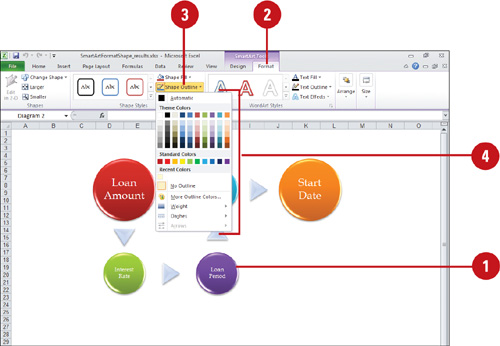
Apply a Shape Effect to a SmartArt Graphic
![]() Select the shapes in the SmartArt graphic you want to modify.
Select the shapes in the SmartArt graphic you want to modify.
![]() Click the Format tab under SmartArt Tools.
Click the Format tab under SmartArt Tools.
![]() Click the Shape Effects button, and then point to one of the following:
Click the Shape Effects button, and then point to one of the following:
![]() Preset to select No 3-D, one of the preset types, or More 3-D Settings.
Preset to select No 3-D, one of the preset types, or More 3-D Settings.
![]() Shadow to select No Shadow, one of the shadow types, or More Shadows.
Shadow to select No Shadow, one of the shadow types, or More Shadows.
![]() Reflection to select No Reflection or one of the Reflection Variations.
Reflection to select No Reflection or one of the Reflection Variations.
![]() Glow to select No Glow, one of the Glow Variations, or More Glow Colors.
Glow to select No Glow, one of the Glow Variations, or More Glow Colors.
![]() Soft Edges to select No Soft Edges or a point size to determine the soft edge amount.
Soft Edges to select No Soft Edges or a point size to determine the soft edge amount.
![]() Bevel to select No Bevel, one of the bevel types, or More 3-D Settings.
Bevel to select No Bevel, one of the bevel types, or More 3-D Settings.
![]() 3-D Rotation to select No Rotation, one of the rotation types, or More 3-D Settings.
3-D Rotation to select No Rotation, one of the rotation types, or More 3-D Settings.
When you point to an effect, a live preview of the style appears in the current shape.
![]() Click the effect you want from the gallery to apply it to the selected shape.
Click the effect you want from the gallery to apply it to the selected shape.

Adding Pictures to a SmartArt Graphic
With SmartArt graphic layouts (New!), you can insert pictures in the SmartArt shapes. In addition to the pictures, you can also add descriptive text using the Text pane or shape itself. The process is very simple. Insert a SmartArt picture layout, insert pictures, and then add descriptive text. If you already have pictures in your document, you can convert them to a SmartArt graphic.
Add a Picture to a SmartArt Graphic
![]() Use either of the following to add pictures to a SmartArt graphic:
Use either of the following to add pictures to a SmartArt graphic:
![]() Create New. Click the Insert tab, click the SmartArt button, click Picture, click a layout, and then click OK.
Create New. Click the Insert tab, click the SmartArt button, click Picture, click a layout, and then click OK.
![]() Convert Picture. Select a picture, click the Format tab under Picture Tools, click the Picture Layout button, and then select a layout.
Convert Picture. Select a picture, click the Format tab under Picture Tools, click the Picture Layout button, and then select a layout.
![]() To add a shape, click the Design tab under SmartArt Tools, click the Add Shape button arrow, and then select the type of shape you want to add.
To add a shape, click the Design tab under SmartArt Tools, click the Add Shape button arrow, and then select the type of shape you want to add.
![]() To add a picture, double-click a graphic placeholder, select a picture file, and then click Insert.
To add a picture, double-click a graphic placeholder, select a picture file, and then click Insert.
![]() Label the shapes by doing one of the following:
Label the shapes by doing one of the following:
![]() Type text in the [Text] box.
Type text in the [Text] box.
![]() Click a shape, and then type text directly into the shape.
Click a shape, and then type text directly into the shape.
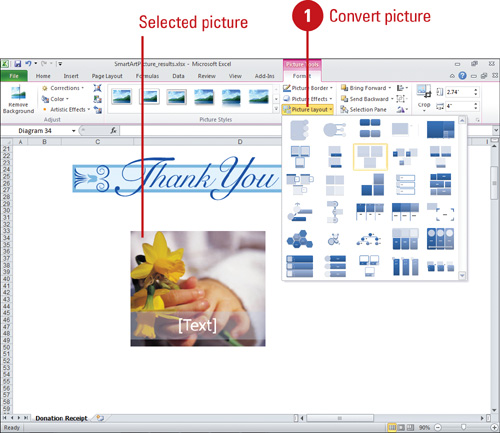

Creating an Organization Chart
An organization chart shows the reporting relationships between individuals in an organization. For example, you can show the relationship between a manager and employees within a company. You can create an organization chart using a SmartArt graphic or using Microsoft Organization Chart. If you’re creating a new organization chart, a SmartArt graphic is your best choice. If you need to match an existing organization chart from a previous version of Excel, Microsoft Organization Chart—an embedded application—is your best choice. A SmartArt graphic organization chart makes it easy to add shapes using the graphic portion or the Text pane.
Create an Organization Chart Using a SmartArt Graphic
![]() Click the Insert tab.
Click the Insert tab.
![]() Click the SmartArt button.
Click the SmartArt button.
![]() In the left pane, click Hierarchy.
In the left pane, click Hierarchy.
![]() In the middle pane, click a SmartArt organization chart type.
In the middle pane, click a SmartArt organization chart type.
![]() Click OK.
Click OK.
The SmartArt graphic appears with a Text pane to insert text.
![]() Label the shapes by doing one of the following:
Label the shapes by doing one of the following:
![]() Type text in the [Text] box.
Type text in the [Text] box.
You can use the arrow keys to move around the Text pane.
![]() Click a shape, and then type text directly into the shape.
Click a shape, and then type text directly into the shape.
![]() To add shapes from the Text pane, place the insertion point at the beginning of the text where you want to add a shape, type the text you want, press Enter, and then to indent the new shape, press Tab or to de-indent, press Shift+Tab.
To add shapes from the Text pane, place the insertion point at the beginning of the text where you want to add a shape, type the text you want, press Enter, and then to indent the new shape, press Tab or to de-indent, press Shift+Tab.
![]() When you’re done, click outside of the SmartArt graphic.
When you’re done, click outside of the SmartArt graphic.
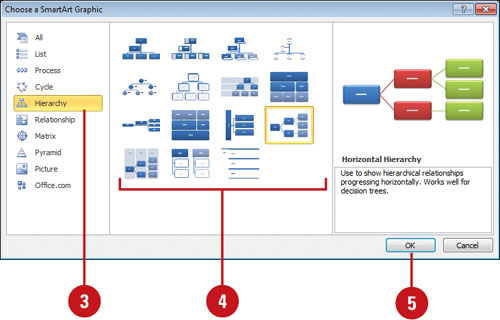
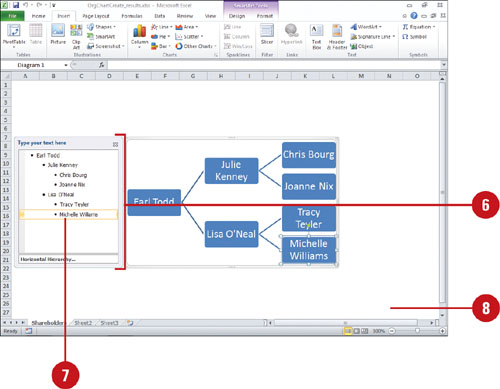
Modifying an Organization Chart
Like any SmartArt graphic, you can add special effects—such as soft edges, glows, or 3-D effects, and animation—to an organization chart. If your organization chart doesn’t quite look the way you want, live preview can help you preview layouts in the Quick Styles and Layout Styles groups and select the one you want. If you only want to change the color, you can choose different color schemes using theme colors by using the Change Color button.
Change the Layout or Apply a Quick Style to an Organization Chart
![]() Click the SmartArt graphic you want to modify.
Click the SmartArt graphic you want to modify.
![]() Click the Design tab under SmartArt Tools.
Click the Design tab under SmartArt Tools.
![]() Click the scroll up or down arrow, or click the More list arrow in the Layouts group or Quick Styles group to see additional styles.
Click the scroll up or down arrow, or click the More list arrow in the Layouts group or Quick Styles group to see additional styles.
The gallery displays different layouts or the current layout with different theme colors.
![]() Point to a style.
Point to a style.
A live preview of the style appears in the current shape.
![]() Click the layout or style for the SmartArt graphic you want from the gallery.
Click the layout or style for the SmartArt graphic you want from the gallery.


